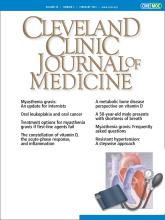Article Figures & Data
Tables
- TABLE 1
Ranking of therapies for acetylcholine receptor antibody-positive generalized myasthenia gravis
First-line Pyridostigmine, prednisone, thymectomya Second-line Azathioprine, mycophenolate mofetil, intravenous immunoglobulin Third-line Methotrexate, tacrolimus,b eculizumab,c ravulizumab,c efgartigimod,c plasmapheresis Fourth-line Rituximab, cyclosporineb Fifth-line Cyclophosphamide ↵a For certain patients with acetylcholine receptor antibody-positive generalized myasthenia gravis without thymoma (see reference 5).
↵b May be considered as an early treatment option, depending on clinical context.
↵c Newer agents with emerging data; may be considered as early treatment option for refractory acetylcholine receptor antibody-positive generalized myasthenia gravis, but cost may be prohibitive.
Based on information in references 5 and 6.
- TABLE 2
Clinical features of fatigable weakness in myasthenia gravis by region of involvement
Muscle group/region Manifestation of fatigable weakness in myasthenia gravis Ocular Fluctuating ptosis (often asymmetrical, worsened by sustained upgaze) with or without variable diplopia
Ptosis may improve with application of an ice pack to the eyes, ie, the bedside ice-pack testBulbar Dysarthria with or without dysphonia; worse at the end of long conversations, when especially nasal-sounding, “mushy,” or “wet” speech is significant
Painless dysphagia, which may include nasal regurgitation, sialorrhea, and frequent throat-clearing, with or without coughing; may range from weak to frank choking
Masticatory or chewing weakness; when severe, the mouth may hang open, and the patient may use a hand to close or manipulate the jawFacial Bilateral weakness with “sagging and expressionless” face and a horizontal smile
Inability to close eyes firmly
Drooling from poorly sealed lips
Inability to whistle, pucker lips, or use a strawAxial Weak Weak flexion or extension of the neck, “dropped” head when severe
Occasional stooped posture with anteroposterior truncal flexion (camptocormia) or lateral trunk flexion (“Pisa syndrome”)Limb or appendicular Weakness that affects proximal more than distal upper and lower limb groups
Difficulty getting up from low-seated positions, using arms for overhead activities like washing hair; worse with repeated and sustained actionsRespiratory Orthopnea
Dyspnea on exertion or with increased intra-abdominal pressure as when bending forward to tie shoelaces, or when trunk is immersed in a pool
Classic features of accessory respiratory muscle use during respiratory distress may be blunted with significant myasthenic weakness of these muscles
Decreased counts (< 20) on a single-breath counting test suggest significant respiratory muscle weakness and risk for respiratory failure






